Noch etwas Dublin bevor ich nach Paris reise? Bitte schön!
Unweit vom Garden of Remembrance in der O`Connel Street erhebt sich ein mit gewaltigem ionischen Säulenvorbau verziertes Gebäude, hat etwas sakrales, ist aber keine Kirche, nein hier wird Merkur gehuldigt, dem Gott der Kommunikation, es ist das Hauptpostamt von Dublin. 1818 erbaut, riesig, schön und immer noch Postamt, schwer beschädigt beim Osteraufstand 1916, hier verlas James Connolly (http://de.wikipedia.org/wiki/James_Connolly) die Unabhängigkeitserklärung, um danach mit seinen Mitstreitern im Gebäude vor dem englischen Beschuss Schutz zu suchen. 1929 wurde das Postamt wieder eröffnet und im großen Vestibül erinnert eine Statue von Cuchulainn, einem Held aus der irischen Mythologie, an den Aufstand und seine Opfer.
Auf der anderen Straßenseite in zweiter Reihe befindet sich St.Mary´s Pro-Cathedral, Dublins bedeutendes katholisches Gotteshaus, dass eigentlich dort in den Himmel ragen sollte, wo nun eben das Postamt steht. Dieser städtebauliche Kniff geht natürlich auf die englischen Besatzer zurück, die eine katholische Machtdemonstration, selbst architektonischer Art an der Magistrale verhindern wollten. Das Gotteshaus entstand in den Jahren 1816 bis 1825 im Bordellbezirk. Nun, die Kirche ist noch da, die Besatzer sind längst fort, ebenso die Bordelle und die verruchte Montgomery Street heißt seit der Unabhängigkeit Cathedral Street. Die Kirche zeigt dorische Säulen, weil dem Tempel des Hephaistos in Athen nachempfunden und hat trotz dessen oder gerade deswegen erstaunliche Ähnlichkeit mit dem Postamt.
Am Eingang wird schriftlich darauf hingewiesen, dass die Kinder hier in der Kirche sicher sind; na dann ist ja alles gut.
Das Innere ist erstaunlich nüchtern, hell, angenehm, und freundliche Freiwillige bestätigten auf Nachfrage, das fotografieren unbedingt erlaubt ist.
Es gibt einen geschnitzten Altar aus dem 18.Jh und ein Gemälde von Jonathan Smyth "Himmelfahrt Jesu", sowie eine Gedenktafel für Matt Talbot, der einst Alkoholiker war und dann zum Asketen wurde, manchmal genügt es nichts zu tun, um heilig zu sein und zum Schluss das Monument für den ersten irischen Kardinal Cullen, dessen Sockelrelief zeigt, was die Aufgaben der Frauen in der Gemeinschaft sind, Alten- und Krankenpflege, Sterbebegleitung, Kinderbetreuung und lauter so unwichtiger Kram, denn "mit dem Weib kam die Sünde in die Welt" (J.Joyce Ulyssus) und den wichtigen Tätigkeiten der Männer, Gespräche führen, ein kleines Buch in einer Hand halten und den Segen erteilen....
Nun hab ich genug Spiritualität getankt, jetzt brauche ich einen Kaffee.
Some Dublin before I´ll travel to Paris? Here you are!
Not far from the Garden of Remembrance in O`Connel Street a big building is rising up, decorated with Ionic Pillars, looks sacral, but it´s not a church, here they worship Mercury, the god of communication, it´s the General Post Office of Dublin. Build in 1818, giant, beautiful, still a post office, heavy demaged during Easter Rising 1916, James Connolly (http://en.wikipedia.org/wiki/James_Connolly) did read here the Declaration of Independence and fled after into the building with his companions to rescue them selfs from the shooting by the english troops. In 1929 the post office was reopened and in the vestibule a statue of Cuchulainn (http://en.wikipedia.org/wiki/Cuchulainn) a hero from the irish mythology reminds of the uprising and it´s victims.
On the other side of the street in second row there is St.Mary´s Pro-Cathedral, Dublin´s most important catholic church, wich should rather be there where now the post office is. This town planning gimmick regresses from the english occupants, wich would like to avert a demonstration of catholic power at the main street, even an architecturally one. The church was build in 1816 - 1825 in the brothel area. So, the church is still there, the occupants are gone, even the brothels and the wicked Montgomery Street is called Cathedral Street since the days of independence. The Lord´s House got Doric Column, after the Temple of Hephaistos in Athen and looks a bit, because of that or despite that, like the post office.
At the entry there is a written note, that kids are save here in the church, ah, that´s good at all.
The interior is astonishing prosaic, bright, pleasant, and friendly volunteers confirm my request, yes please, taking pictures is definitly permitted.
There is a carved altar from the 18th cent., a painting by Jonathan Smyth "Ascension of Jesus", a plaque for Matt Talbot, once an alcohol addicted, than an ascetic- sometimes it´s enough to do nothing to become a holy man and last but not least the sculpture of the first irish cardinal Cullen. The plinth panel shows the tasks of women in the community like elder care, nursing, end-of-life care, child care and all those lazy stuff, because "with the trull the sin came to the world" (J.Joyce Ulyssus) and the very importent work of the male, like chatting, holding a small book with one hand and blessing...
Now that´s enough spirituality, I go for a coffee.
























Keine Kommentare:
Kommentar veröffentlichen